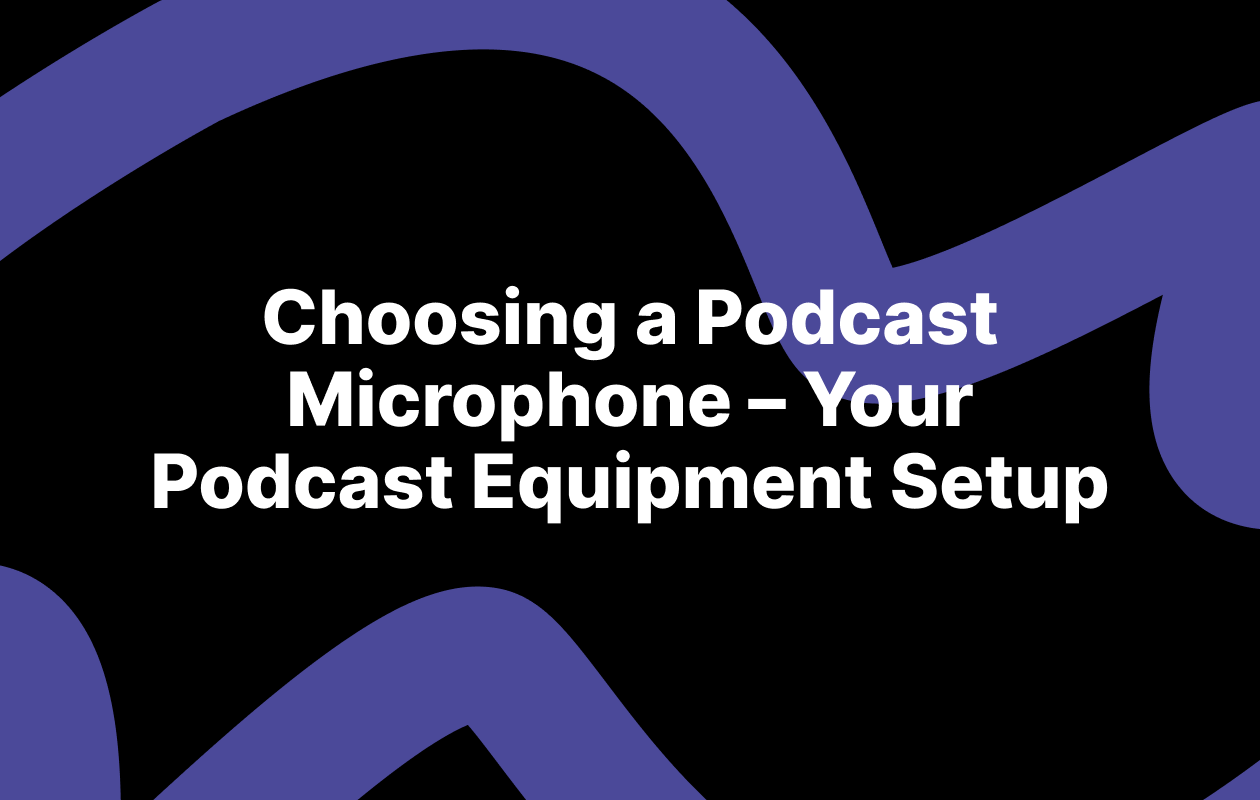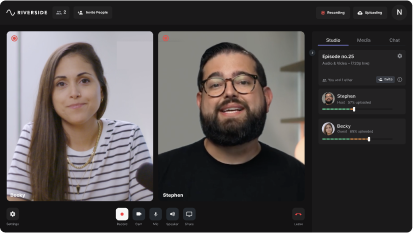Last Updated
May 26, 2023
Condenser Microphone: Buyer Guide to Pick The Best One
.jpg)
Still can’t decide what condenser microphone to buy?
We know it can be overwhelming with so many options on the market. Plus, all the technical jargon doesn’t make it much easier. But, it doesn’t have to be so complicated to find a studio-quality recording microphone.
This article reviews the best condenser microphones on the market, and we go over the essentials to help you choose the ideal one.
What is a condenser microphone?
Condenser microphones, also known as ‘capacitor mics,’ are a type of microphone that converts sound waves into audio signals through capacitance.
A condenser mic's membrane is suspended close to a solid metal plate. There is a current flowing across these two components. When sound waves hit the membrane, they cause it to move back and forth, thus the fluctuating distance between it and the metal plate. This causes the capacitance to change, and this is how the mic interprets the sound waves into audio.
Condenser mics require an external power source to work - often referred to as ‘phantom power.’
What's the difference between condenser and dynamic microphones?
The ultimate function of condenser and dynamic mics is the same, but there are some key differences that you should be aware of.
They convert sound into audio differently
Firstly, dynamic mics convert sound into audio using electromagnetism instead of capacitance.
Power source
In addition, while condenser mics need a power source to work, dynamic mics don’t.
Sensitivity
Condenser mics are generally better for capturing delicate, nuanced sounds and higher frequency sounds. Dynamic mics are better suited to live environments with louder and stronger sound sources such as drums. Meanwhile, condenser mics perform best in a studio environment.
Durability
Finally, condenser mics tend to be far more delicate and susceptible to damage if not handled carefully because of their construction. By contrast, dynamic mics are robust and durable, even if roughly handled.
If you want to find more dynamic mics, check out our in-depth guide.
Large versus Small Diaphragm Condenser Mics
Although the physical difference between a large and small diaphragm condenser mic might be noticeable, let’s look at how this affects the mic's functionality.
Larger diaphragms have less self-noise
Large-diaphragm condenser mics typically produce less self-noise, which is a big plus for conserving the high-quality of your audio.
Larger diaphragms are more versatile
Large-diaphragm condenser microphones will do well in just about every application. This doesn’t necessarily mean they’ll give you the exquisite sound quality of a small diaphragm mic, but what it does give you is flexibility in how you use your mic.
Smaller diaphragms produce higher-fidelity sound
Smaller diaphragms are more accurate, producing higher-fidelity sound than large-diaphragm mics.
Smaller diaphragms have a broader frequency response
In addition, small diaphragm condenser mics boast a far more comprehensive frequency response range.
Smaller diaphragms have a consistent pickup pattern
A consistent pickup pattern refers to how consistently a mic performs as you rise through the frequencies. A consistent pickup pattern is a cornerstone of a good quality mic.
What are the Benefits of a Condenser Mic?
Compact
Condenser mics tend to be small and highly portable. But don’t let that fool you. These mics seriously pack a punch in terms of audio quality.
Can pick up delicate sounds
Condenser mics are known to pick up delicate and nuanced sounds far better than their dynamic counterparts.
Can pick up high-frequency sounds
Condenser mics perform much better at picking up higher frequency sounds.
How to Choose the Best Condenser Mic
When it comes to choosing your condenser mic, the most significant piece of advice is to find a mic that works for you. If the highest recommended mic just doesn’t do it for you, that’s ok. Your voice and specific setup will mean you have particular needs compared to another podcaster. That said, there are some common factors to keep in mind.
Your Budget
Before you start browsing mic options, you’ll need to settle on how much you’re willing to spend on your microphone. Don’t worry, even if you’ve got a strict budget, you’ll be able to find a mic that works well for your needs.
Microphone Applications
Next, you’ll need to think about your needs, wants, and how you will be using this microphone. What kinds of sounds will you be recording? And in what kinds of environments? If you’re solely a podcaster, your primary focus will be vocals. However, if you’re also an instrumentalist, for example, you may want to look into whether your chosen mic works well with your instrument of choice.
Connectivity
If you’re looking for a plug-and-play mic, you’re most likely looking for a USB condenser mic. If you’re a stickler for quality and have the money to spend on an audio interface and xlr cable, however, then you’ll be able to look at XLR condenser mic options too.
Size of the diaphragm
As we saw earlier, the size of your mics diaphragm can impact its performance at higher frequencies and how accurate the audio it produces is.
The Polar Patterns
Another huge consideration is your mic’s polar pattern. You’ll have to choose between cardioid, super-cardioid, bi-directional, and omnidirectional. All of these are more or less suitable, depending on what you’re recording and where.
Cardioid
A cardioid pickup pattern is named for its heart shape. A cardioid mic will predominantly pick up sound from in front of the mic. A hyper-cardioid mic is essentially a more extreme version of this. Hyper-cardioid mics do the same, blocking out any other external noise more effectively.
Bi-directional
Bi-directional mics pick up sound from two directions: the front and back of the mic.
Omnidirectional
Omnidirectional mics pick up sound from 360 degrees.
The Frequency Response
The frequency response indicates what range of frequencies your mic can pick up on. It also tells you how your mic performs at any given frequency. For example, one mic might perform better for highs versus lows or vice-versa. A typical frequency response range goes between 20 and 20,000 Hz, although it varies depending on the mic and maker.
The Best Condenser Microphones for 2023
1. Blue Snowball iCE Condenser

- Price: $39.99
- Polar pattern: Cardioid
- Diaphragm size: Large diaphragm
- Frequency response: 40 - 18,000 Hz
- Connectivity: USB
Why we like it:
This mic is a seriously budget-friendly option for podcasters (and streamers) looking for a mic that won’t break the bank. Plus, the fact that it’s a USB mic means that you can get started with it right away.
2. MXL 770 Multipurpose Mic

- Price: $84.95
- Polar pattern: Cardioid
- Diaphragm size: Large diaphragm
- Frequency response: 30 - 20,000 Hz
- Connectivity: XLR
Why we like it:
The MXL 770 offers super smooth audio quality that boasts excellent clarity for a cardioid condenser mic at this price point. If you’re looking for a condenser mic under $100, this is an excellent option for you.
3. Rode NT1

- Price: $269.00
- Polar pattern: Cardioid
- Diaphragm size: Large diaphragm
- Frequency response: 20 - 20,000 Hz
- Connectivity: XLR
Additional features:
- Ultra-low noise circuitry for reduced self-noise
- High-durable housing
Why we like it:
The Rode NT1 is a highly well-priced all-rounder mic that offers excellent audio clarity. This is a strong choice for any podcaster, streamer, or content creator looking for a new mic.
4. Audio Technica AT 2035

- Price: $149.00
- Polar pattern: Cardioid
- Diaphragm size: Large diaphragm
- Frequency response: 20 - 20,000 Hz
- Connectivity: XLR
Other features:
- Custom shock mount
Why we like it:
The Audio-Technica AT 2035 is aimed at being an all-rounder. The large-diaphragm means this great microphone for musicians, vocalists, and podcasters alike.
5. Shure SM 27

- Price: $349.00
- Polar pattern: Cardioid
- Diaphragm size: Large diaphragm
- Frequency response: 20 - 20,000 Hz
Other features:
- Integral pop filter
- In-built shock mount
- Low-self noise
6. Audio Technica AT5040

- Price: $2,999.00
- Polar pattern: Cardioid
- Diaphragm size: Large diaphragm
- Frequency response: 20 - 20,000 Hz
Other features:
- Integral pop-protection
- In-built shock mount
- Low-self noise
What is the Best Condenser Microphone for vocals and podcasting?
The Shure SM 27 is a strong contender for a condenser vocal microphone because of its ability to pick up nuanced and detailed sounds. Its integrated pop-protection and shock-mount protect the integrity of your audio and ensure you capture the best recording possible.
You can also try the Rode NT 1 with its effective cardioid pattern that reduces unwanted background noise. It is a very quiet microphone and produces little self-noise, making sure any vocals you record are crisp and clear.
What is the best condenser mic for professionals?
The Audio-Technica AT5040 is explicitly designed for recording vocals, and you can tell. At this high-end price point, you expect the audio quality you’ve always dreamed of, and the Audio Technica at5040 doesn’t let you down. Whether you're recording in a professional or home studio, the Audio Technica AT5040 has you covered.
Best practices for condenser microphones
- Use the correct mic positioning: Your mouth shouldn’t touch your mic. It’s best to position your mic at least 2-6 inches away from your mouth and angled at about 45 degrees to your face. We suggest playing around with positioning until you're happy with how recordings sound.
- Record in a soundproof room: Condenser microphones are highly sensitive to noise, so even a background fan can interfere with recordings. It’s best to record in a space without any background noise. Learn how to build your own soundproof studio with our guide.
- Use compatible and studio-quality recording software: It doesn’t help if you have a top-quality mic with software that can’t capture high-resolution audio. Luckily with Riverside, it’s easy to capture lossless audio at up to 48kHz audio resolution! Learn more, or start recording professional audio seamlessly!
FAQs about Condenser Mics
Are condenser mics better?
Ultimately, it comes down to what you’ll be using your mic for and what your personal preference is. Technically speaking, condenser mics are better for capturing detailed soundscapes. That being said, you’ll come across musicians, vocalists, and podcasters alike who opt for their microphone simply on how well it works for them, rather than focusing on condenser v dynamic.
What’s a good condenser mic?
The Audio Technica AT5040 is an excellent bet if you have no financial constraints.
What are the disadvantages of a condenser microphone?
Condenser mics are fragile and need to be handled to avoid damage. In addition, the need for a power supply can be cumbersome, especially if you’re someone who’s frequently on the go.
















.png)
.png)
 (1).webp)
.webp)
.webp)








